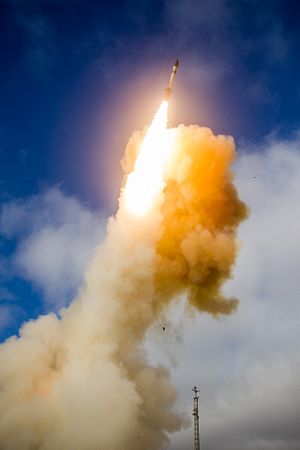On June 6, the United States and Japan successfully conducted a live-fire test of a jointly developed new ballistic missile interceptor at a U.S. Navy sea range.
Raytheon Co’s next-generation Standard Missile-3 (SM-3) Block IIA, has been under joint development by the U.S. defense firm Raytheon and Japan’s Mitsubishi Heavy Industries, the country’s largest defense contractor. According to IHS Jane’s Defense Weekly,Raytheon was contracted for hardware, system development, and all-up-round integration, whereas Japan’s Mitsubishi Heavy Industries focused on the missile’s second and third stage rocket motors, steering control, and the missile nosecone.
The United States contributed a little over $2 billion to the weapon program, which began in 2006, while Japan provided around $1 billion in funds. Reuters quoted Riki Ellison, head of the US-based Missile Defense Advocacy Alliance, who notes that this “is the U.S. Department of Defense’s best case of equal funding and engineering shared with an allied country to develop and … field a new weapon system to better enhance the national security of both nations.”
In detail, the SM-3 Block IIA is designed to destroy short- to intermediate-range ballistic missile threats in space and can be deployed at land-based Aegis Ashore sites. The Raytheon company website elaborates on two distinct new features: “[L]arger rocket motors that will allow it to defend broader areas from ballistic missile threats and a larger kinetic warhead.”
Consequently, in comparison to previously developed SM-3 Block missiles, the SM-3 Block IIA “will engage threats sooner and protect larger regions from short- to intermediate-range ballistic missile threats,” the news release states. The missile, which works in conjunction with the U.S. Aegis combat system (also in use on Japanese naval ships), is the world’s “only ballistic missile killer deployable on land and sea,” according to the Raytheon company website.
Last week’s test was jointly announced by the Technical Research and Development Institute (TRDI) of Japan’s Ministry of Defense (MOD), and the U.S. Missile Defense Agency (MDA), in cooperation with the U.S. Navy illustrating the scope of joint U.S.-Japanese cooperation on this project.
“The SM-3 Cooperative Development project is the joint U.S.-Japan development of a 21-inch diameter variant of the SM-3 missile (…) Aegis Ballistic Missile Defense (BMD) is the naval component of the Ballistic Missile Defense System (BMDS),” the MDA statement explains.
The test itself, conducted at the Point Mugu Sea Range on San Nicolas Island in California, did not involve the interception of a target as the MDA notes:
This test, designated SM-3 Block IIA Cooperative Development Controlled Test Vehicle-01, was the first live fire of the SM-3 Block IIA. The missile successfully demonstrated flyout through nosecone deployment and third stage flight. No intercept was planned, and no target missile was launched,” the MDA stated in a press release.
SM-3 Block IIA will have a total of five more flight tests through 2018, the scheduled date of the missiles deployment at sea and on land as Mitch Stevison, Raytheon’s senior SM-3 program director, explained to IHS Jane’s Defense Weekly:
We will be demonstrating end-to-end missile performance that will test the capability of the Kinetic Warhead with its larger TDACS [throttleable divert and attitude control system], which supports longer range missions,” Stevison said. “The first SM-3 IIA intercept test will occur in 2016 followed by other intercept test prior to deployment in 2018.

































